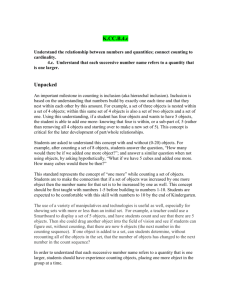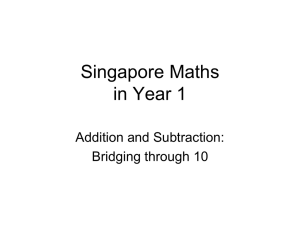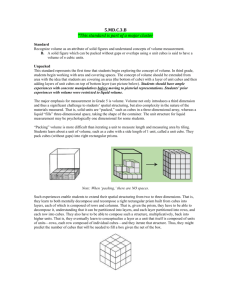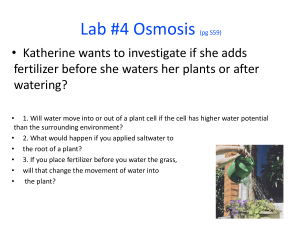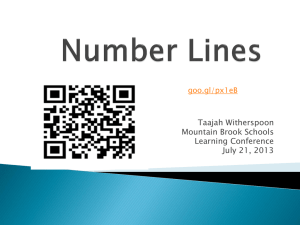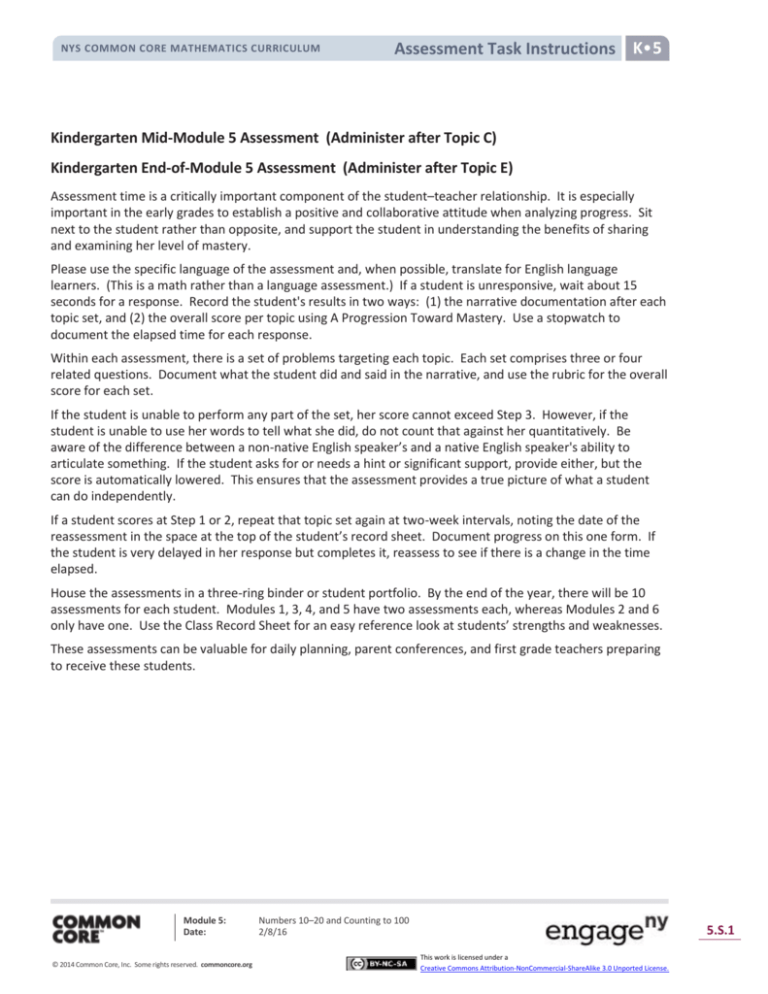
NYS COMMON CORE MATHEMATICS CURRICULUM
Assessment Task Instructions K•5
Kindergarten Mid-Module 5 Assessment (Administer after Topic C)
Kindergarten End-of-Module 5 Assessment (Administer after Topic E)
Assessment time is a critically important component of the student–teacher relationship. It is especially
important in the early grades to establish a positive and collaborative attitude when analyzing progress. Sit
next to the student rather than opposite, and support the student in understanding the benefits of sharing
and examining her level of mastery.
Please use the specific language of the assessment and, when possible, translate for English language
learners. (This is a math rather than a language assessment.) If a student is unresponsive, wait about 15
seconds for a response. Record the student's results in two ways: (1) the narrative documentation after each
topic set, and (2) the overall score per topic using A Progression Toward Mastery. Use a stopwatch to
document the elapsed time for each response.
Within each assessment, there is a set of problems targeting each topic. Each set comprises three or four
related questions. Document what the student did and said in the narrative, and use the rubric for the overall
score for each set.
If the student is unable to perform any part of the set, her score cannot exceed Step 3. However, if the
student is unable to use her words to tell what she did, do not count that against her quantitatively. Be
aware of the difference between a non-native English speaker’s and a native English speaker's ability to
articulate something. If the student asks for or needs a hint or significant support, provide either, but the
score is automatically lowered. This ensures that the assessment provides a true picture of what a student
can do independently.
If a student scores at Step 1 or 2, repeat that topic set again at two-week intervals, noting the date of the
reassessment in the space at the top of the student’s record sheet. Document progress on this one form. If
the student is very delayed in her response but completes it, reassess to see if there is a change in the time
elapsed.
House the assessments in a three-ring binder or student portfolio. By the end of the year, there will be 10
assessments for each student. Modules 1, 3, 4, and 5 have two assessments each, whereas Modules 2 and 6
only have one. Use the Class Record Sheet for an easy reference look at students’ strengths and weaknesses.
These assessments can be valuable for daily planning, parent conferences, and first grade teachers preparing
to receive these students.
Module 5:
Date:
© 2014 Common Core, Inc. Some rights reserved. commoncore.org
Numbers 10–20 and Counting to 100
2/8/16
5.S.1
This work is licensed under a
Creative Commons Attribution-NonCommercial-ShareAlike 3.0 Unported License.
Mid-Module Assessment Task K
NYS COMMON CORE MATHEMATICS CURRICULUM
Student Name
Date 1
Topic B
Time Elapsed
Materials: (S) 19 loose straws (or another set of objects in the
classroom)
T:
T:
T:
Date 3
Topic A
Topic A: Count 10 Ones and Some Ones
Rubric Score
Date 2
Topic C
Count 10 straws into a pile. Whisper while you count so I can hear you.
Count 6 more straws into a different pile.
Count 10 straws and 6 more straws the Say Ten Way. (Pause.) How many straws do you have?
(If the student says the number the Say Ten Way, ask the student to also say it the regular way.)
What did the student do?
What did the student say?
Topic B: Compose Numbers 11–20 from 10 Ones and Some Ones; Represent and Write Teen Numbers
Rubric Score
Time Elapsed
Materials: (S) 19 cubes, work mat, marker, Hide Zero cards
T:
T:
T:
T:
(Show the numeral 13.) Move this many cubes onto your work mat.
Use the Hide Zero cards to show the number of cubes on your work mat.
Hand me the cubes that the 1 is telling us about. (Point to the 1 of 13 on the numeral 13.)
(Put 3 more cubes.) This is 16 cubes. Please write the number 16 on your work mat.
What did the student do?
Module 5:
Date:
© 2014 Common Core, Inc. Some rights reserved. commoncore.org
What did the student say?
Numbers 10–20 and Counting to 100
2/8/16
5.S.2
This work is licensed under a
Creative Commons Attribution-NonCommercial-ShareAlike 3.0 Unported License.
NYS COMMON CORE MATHEMATICS CURRICULUM
Mid-Module Assessment Task K
Topic C: Decompose Numbers 11–20, and Count to Answer “How Many?” Questions in Varied Configurations
Rubric Score
Time Elapsed
Materials: (S) 19 cubes
T:
T:
T:
T:
(Set out 15 cubes in a scattered configuration.) Count 12 cubes into a straight line. (Pause.) How
many cubes are there counting the regular way? The Say Ten Way?
Move the cubes into 2 rows.
a. How many cubes are there? (Assessing for conservation.)
b. Please show me how you count these cubes that are now in rows.
Move the cubes into a circle.
a. How many cubes are there? (Assessing for conservation.)
b. Please show me how to count these cubes that are now in a circle.
Put one more cube in your circle. How many cubes do you have now?
What did the student do?
Module 5:
Date:
© 2014 Common Core, Inc. Some rights reserved. commoncore.org
What did the student say?
Numbers 10–20 and Counting to 100
2/8/16
5.S.3
This work is licensed under a
Creative Commons Attribution-NonCommercial-ShareAlike 3.0 Unported License.
NYS COMMON CORE MATHEMATICS CURRICULUM
Mid-Module Assessment Task K
Mid-Module Assessment Task
Standards Addressed
Topics A–C
Know number names and the count sequence.
K.CC.1
Count to 100 by ones and by tens.
K.CC.3
Write numbers from 0 to 20. Represent a number of objects with a written numeral 0–20
(with 0 representing a count of no objects).
Count to tell the number of objects.
K.CC.4
K.CC.5
Understand the relationship between numbers and quantities; connect counting to
cardinality.
b.
Understand that the last number name said tells the number of objects counted. The
number of objects is the same regardless of their arrangement or the order in which
they were counted.
c.
Understand that each successive number name refers to a quantity that is one larger.
Count to answer “how many?” questions about as many as 20 things arranged in a line, a
rectangular array, or a circle, or as many as 10 things in a scattered configuration; given a
number from 1–20, count out that many objects.
Work with numbers 11-19 to gain foundations for place value.
K.NBT.1
Compose and decompose numbers from 11 to 19 into ten ones and some further ones,
e.g., by using objects or drawings, and record each composition or decomposition by a
drawing or equation (e.g., 18 = 10 + 8); understand that these numbers are composed of
ten ones and one, two, three, four, five, six, seven, eight, or nine ones.
Evaluating Student Learning Outcomes
A Progression Toward Mastery is provided to describe and quantify steps that illuminate the gradually
increasing understandings that students develop on their way to proficiency. In this chart, this progress is
presented from left (Step 1) to right (Step 4). The learning goal for students is to achieve Step 4 mastery.
These steps are meant to help teachers and students identify and celebrate what the students CAN do now
while pointing the way toward what they need to work on next.
Module 5:
Date:
© 2014 Common Core, Inc. Some rights reserved. commoncore.org
Numbers 10–20 and Counting to 100
2/8/16
5.S.4
This work is licensed under a
Creative Commons Attribution-NonCommercial-ShareAlike 3.0 Unported License.
NYS COMMON CORE MATHEMATICS CURRICULUM
Mid-Module Assessment Task K
A Progression Toward Mastery
Assessment
Task Item
Topic A
K.NBT.1
K.CC.1
Topic B
K.NBT.1
K.CC.3
STEP 1
Little evidence of
reasoning without
a correct answer.
STEP 2
Evidence of some
reasoning without
a correct answer.
(1 point)
(2 points)
The student shows little
evidence of counting
ability or
understanding. Almost
non-responsive.
The student shows little
evidence of
understanding how to
represent a teen
number and/or use
Hide Zero cards.
The student writes the
number 16 incorrectly.
STEP 3
Evidence of some
reasoning with a
correct answer or
evidence of solid
reasoning with an
incorrect answer.
(3 points)
STEP 4
Evidence of solid
reasoning with a
correct answer.
The student shows
evidence of beginning
to understand counting
beyond 10 but counts
the quantity
incorrectly, (i.e., lacks
organization, consistent
1:1 correspondence,
etc.).
The student correctly
counts 10 straws into a
pile, and then 6 straws,
but is unable to count
to 16.
The student correctly:
The student shows a
beginning
understanding of
representing teen
numbers and using
Hide Zero cards but is
unable to answer
correctly.
The student correctly
counts 13 cubes and
accurately uses the
Hide Zero cards, but
produces an incorrect
quantity to represent
the 1 in 13.
The student writes the
number 16 incorrectly.
The student identifies a
group of 10 as
representing the ‘1’ in
13 but cannot use the
Hide Zero cards
accurately.
(4 points)
Counts 10 straws
into a pile, and then
6 straws.
Counts from 1 to 16.
Counts the Say Ten
Way starting with
the group of 10,
“…ten one, ten two,
ten three, ten
four…” all the way
up to 16.
OR
The student correctly:
Counts 13 cubes and
selects both the 10
and 3 Hide Zero
cards to accurately
make 13.
Identifies a group of
10 as being
representative of the
1 in the numeral 13.
Writes the numeral
16.
The student writes the
numeral 16 correctly.
Module 5:
Date:
© 2014 Common Core, Inc. Some rights reserved. commoncore.org
Numbers 10–20 and Counting to 100
2/8/16
5.S.5
This work is licensed under a
Creative Commons Attribution-NonCommercial-ShareAlike 3.0 Unported License.
NYS COMMON CORE MATHEMATICS CURRICULUM
Mid-Module Assessment Task K
A Progression Toward Mastery (continued)
Assessment
Task Item
Topic C
K.CC.4b
K.CC.4c
K.CC.5
K.NBT.1
STEP 1
Little evidence of
reasoning without
a correct answer.
STEP 2
Evidence of some
reasoning without
a correct answer.
(1 point)
(2 points)
The student shows little
evidence of
understanding how to
make or count objects
in arrays and circles.
The student shows
evidence of beginning
to understand counting
arrays and circles but is
unable to do so
accurately and
consistently.
STEP 3
Evidence of some
reasoning with a
correct answer or
evidence of solid
reasoning with an
incorrect answer.
(3 points)
STEP 4
Evidence of solid
reasoning with a
correct answer.
The student arranges
and counts each array
and circle correctly but
cannot add one more
and identify the new
quantity.
The student correctly:
The student recounts
to know that it is 12.
OR
The student adds one
more and identifies the
new quantity but
struggles with one or
more of the counting
array tasks.
Module 5:
Date:
© 2014 Common Core, Inc. Some rights reserved. commoncore.org
(4 points)
Counts 12 cubes.
Arranges and counts
each array and
knows the total is 12
without recounting.
Arranges and counts
in a circle and knows
the total is 12
without recounting.
Adds 1 more to the
quantity and
determines the new
quantity with or
without recounting.
Numbers 10–20 and Counting to 100
2/8/16
5.S.6
This work is licensed under a
Creative Commons Attribution-NonCommercial-ShareAlike 3.0 Unported License.
NYS COMMON CORE MATHEMATICS CURRICULUM
Mid-Module Assessment Task K
Class Record Sheet of Rubric Scores: Module 5
Student Names:
Topic A:
Count 10 Ones and
Some Ones
Module 5:
Date:
© 2014 Common Core, Inc. Some rights reserved. commoncore.org
Topic B:
Compose Numbers
11–20 from 10
Ones and Some
Ones; Represent
and Write Teen
Numbers
Topic C:
Decompose
Numbers 11–20,
and Count to
Answer “How
Many?” Questions
in Varied
Configurations
Next Steps:
Numbers 10–20 and Counting to 100
2/8/16
5.S.7
This work is licensed under a
Creative Commons Attribution-NonCommercial-ShareAlike 3.0 Unported License.



